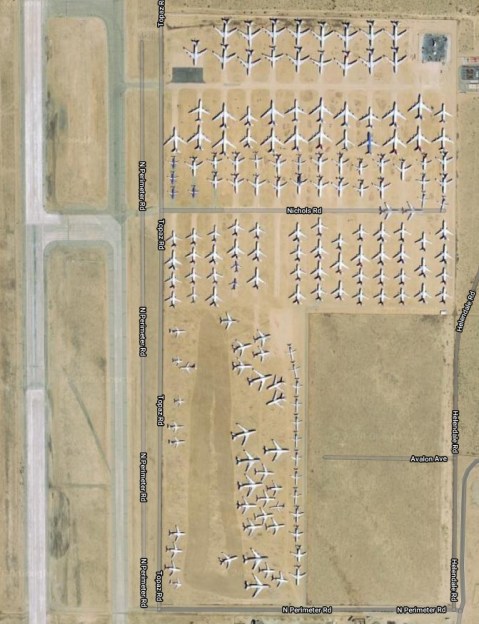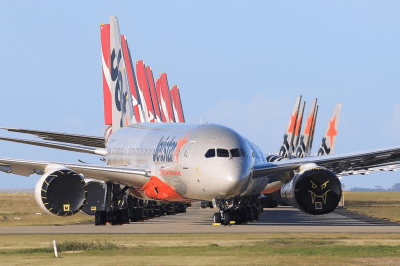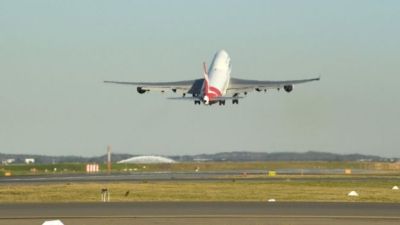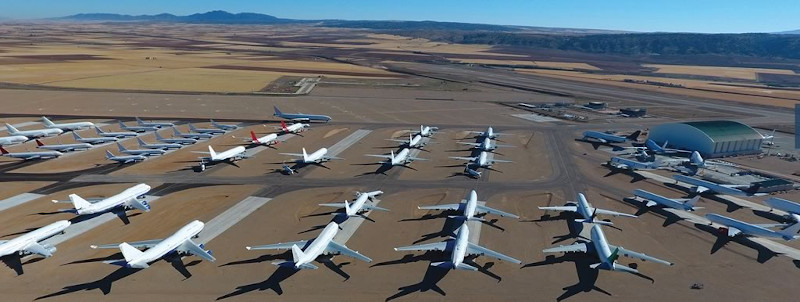Ask any airline executive what their plans were back in January 2020, and you’d probably get the expected spiel about growing market share and improving returns for shareholders. Of course, the coronovirus pandemic quickly changed all that in the space of just a few months. Borders closed, and worldwide air travel ground to a halt.
Suddenly, the world’s airlines had thousands of planes and quite literally nowhere to go. Obviously, leaving the planes just sitting around in the open wouldn’t do them any good. So what exactly is involved in mothballing a modern airliner?
Location, Location, Location

Popular locations in the US include Victorville in California and facilities in Arizona, where conditions are favorable. Similar facilities run overseas, with European airlines looking towards Spain and Australian airlines storing some aircraft in the dry climate of Alice Springs. Often, if cool and dry isn’t on the table, hot and dry is a good second-best option. As important as the location is the presence of skilled maintenance staff to carry out the work. Many airlines prefer to store their planes in locations where they can rely on their own engineering crews to look after their precious assets.
Parking Vs. Storage
When an airline decides a plane won’t be flying commerical routes for a while, a decision has to be made as to how long the plane will be decommissioned. Exact practices vary, but most draw a distinction between active parking and long-term storage.

Active parking concerns planes that are being kept in a ready-to-fly or almost-ready-to-fly configuration. These planes are most typically stored at airports or facilities relatively nearby their typical operational routes. Planes in active parking are intended to be ready to rejoin the flight line within 24-48 hours when needed. In this regime, parts like landing gears will be specially lubricated and engine covers will be fitted to keep out insects and birds as well as corrosion. Other apetures, such as holes for pitot tubes and vents, will similarly be sealed. The aircraft will also be moved slightly every few weeks to avoid flat spotting the tyres. Engines, hydraulic systems, and electronics will be powered up at regular intervals every few weeks to ensure the plane remains in a functional state. This avoids negative effects such as capacitors failing from lack of use or bearings flat-spotting from long periods of sitting. Planes will also be flown periodically on short flights to ensure airworthiness.
Long-term storage is for planes that are intended to be out of action for many months before they will be called upon again. In the current climate, this is particularly relevant for large-capacity widebody aircraft, as low demand will see smaller twin-engined jets serving the majority of routes for the foreseeable future. In these cases, more work is done to prepare the aircraft for storage. Engines may be “pickled”, where their normal lubricants are replaced with special anti-corrosion agents designed to minimise the effects of time. For longer-term storage, the engines may be removed entirely and shipped back to the manufacturer.
More effort may be placed on more labor-intensive preservation methods, designed to reduce the ongoing effort required to maintain the plane in storage. Regular engine starts, landing gear checks and hydraulic tests are avoided, at the expense of the aircraft needing to go through a longer process to rejoin the flightline at the end of storage. In some cases, companies like Airbus mandate that any stored aircraft must be brought back to flight-ready status after two years, before a further storage period. With such restrictions on the table, many airlines will elect to retire or recycle an aircraft at this point rather than continue to pay the high costs of storage. Many larger aircraft, like the 747, are facing early retirement for this very reason.
It’ll Get Worse Before It Gets Better

With the pandemic raging and no end in sight, air travel looks set to remain in the doldrums for years to come. Current estimates expect the industry to be back at pre-pandemic levels by 2024 at the earliest. This has led to flow-on problems, with existing aircraft no longer the only problem. Boeing hit record production levels of the 787 Dreamliner at precisely the wrong time, and is now stuck holding an excess of undelivered aircraft. This follows on from the issues the company already faced, trying to find enough parking for grounded 737 MAX aircraft.
Thankfully, the checklist-focused and highly dilligent aerospace industry was prepared with procedures in place to handle such a situation. The real hurdle is merely overcoming the sheer scale of the problem, in both space and time. In future years, expect to see great turnover in fleets as airlines turn to newly delivered planes to replace older craft that have spent just a little too long cooking out in the desert.
Pour one out for the great flying giants of yesteryear, and maybe ask your local boneyard magnate to shout the next round at the pilot’s bar.

















When there is a problem named at one site there is usually a solution at another on the very same day. Isn’t the internet awesome?!?
https://www.space.com/lava-tubes-mars-and-moon-habitable.html
Alright! Strip those wings off, and I’ll convert one into a summer home!
Leave the wings on and one has the ultimate mobile home.
That’s what John Travolta did :)
One family got a retired jet, had it delivered and set up near a local airport. They live on the plane (after conversion) and the wings cover an awesome patio, part of which allows watching takeoffs and landings at the little field adjacent to their property.
Ned a giant parking garage. Something sized like the NASA assembly building.
“Current estimates expect the industry to be back at pre-pandemic levels by 2024 at the earliest.”
Back? why back? it is fine. Koyaanisqatsi. :)
+1
X 2
What is fine with this? I hope this f… stupidity, fighting a virus from a china with methods of dictatorship, like curfews and other restrictions of basic human rights, is not “fine”. And it is not “fine”, that the government interferes with my wishes to travel or make vacation were and when I want.
So hopefully we are back to _real_ normality better sooner than later.
Time to swallow storng UV light and shoot some disinfectant… sorry no pill for you.
“my body, my choice”
-NARAL
No need to guess why the USA is doing so badly compared to civilised countries when people have this attitude.
You are free to travel. Anytime, anywhere.
Just provide your own plane or similar.
And your own airport. For take off and landing.
Freedom is there, don’t delay. You are free. No excuses.
+1 too.
“My liberty ends where yours begins.”
I should get some stickers printed that read that.
I wonder if it would be affordable yet to “ship” packages via the airlines for personal purposes.
It is high time for “palettisation” (or rather “encapsulation”) and “integrated transport” of passengers. Small vehicles for one or two passengers, with standardized outer volume, densely packable, with short autonomy on batteries and able to be remotely conducted to terminals, closed-circuit (or attached to carrier vehicle provider system doing separation) life support system…
You mean an intermodal container for passengers? Not a bad idea.
No need to exit the “pod” from home to the destination hotel. Make it single person, two person, four person, with space under it for luggage. Buy or borrow the pod with right size, pack it, call podtaxi, get hauled to the airport, chcek in without leaving the pod, get packed into the plane, get unpacked to another taxi and exit the pod on a pod parking under the hotel, on your camping lot or just about anywhere. You will only need to leave it for the toilets, and it can be locked. put the thing on wheels with an engine you can borrow at destination, and you have a podcar!
I would rather stay in a pod than need to check in, checkout, leave my luggage somewhere and then waiting to pick it up, this all sucks.
Elon Musk, make those a reality!
“I would rather stay in a pod than need to check in, checkout, leave my luggage somewhere and then waiting to pick it up, this all sucks.”
Yeah, a few years ago, my wife, daughter, and I took a 2 week vacation traveling through 5 States.
Each day it was,
Find a hotel/motel
Check in
Haul luggage (~1 hour)
Unpack
Next morning
Eat breakfast,
Pack
Haul luggage
Check out
Haul luggage
Drive and do touristy things
Repeat
We’re seriously considering an RV rental next time.
Agreed. Resource consumption of airflight isn’t currently sustainable. Until we have an engineering solution to that, slowing down is the only strategy making sense.
I worked it out a few months ago – 2 people flying to Puerto Rico from NY used roughly the same amount of fuel and hence released similar CO2 as driving a Prius with two people in it, except the Prius couldn’t drive over the ocean. The third person pushed it carbon positive – the Prius would win, assuming the plane was going to be full anyway. But, yeah, airplane emissions are barely regulated and are sky high (see what I did there?), while the Prius is pretty clean by comparison.
you don’t know abut the Prius cleanness. you cannot point to the exact power plant the energy came from: was it coal, gas, hydro, solar, wind or nuclear.
there is no zero emission, just emission by proxy (but that does not sound sexy on the back of your car…)
Not sure what you’re talking about, the Prius runs on fossil fuel just like jet aircraft.
Most modern Prius are plug in hybrids so they do have small batteries and regen capabilities. It would be a interesting to see how different vehicles compared to aircraft.
How does train travel compare? It would be interesting to see a modern high speed rail system in the USA. It seems like a good candidate as it has a large landmass to traverse
I think we will see huge train renaissance. They could be sitting for years and then are pretty much ready for a ride. Aircraft cost fortune even as a sitting duck.
Train renaissance? No.
When I want to travel with land speed, then I take the car. No limitation to schedules or stations.
For long distance I prefer the fastest means of transportation: The plane
Those arrogant environmentalists try to decide over MY use of time. and MY lifestyle – that’s not in their range of competence.
[Rich] “How does train travel compare?”
If it is Amtrak, it sucks. you’re better off hitchhiking and eating road kill.
Train travel is considerably faster than car, in West-Europe. It also as expensive as plane travel (or more) even with government subsidies.
Those no-limit highways are just to get people excited, my travelling average is 120km/h in Germany, at best, while on highways in other countries is 130-140.
Not a rant, I still choose the car for long-range mobility, but the only reason is flexibility and sometimes cost.
Next to no technology is currently sustainable, extreme austerity can delay the time till peak everything hits us … but you’ll need to limit a lot more than just flight.
Really interesting blog post. How about a follow-on post on what they do with airplanes they decide to retire? Where do they go? What happens to them?
What I see is they either get bought by other operators or scrapped. It is quite lucrative to purchase an old passenger airliner and convert it to a cargo plane, FedEx and UPS do it all the time (soon Amazon will be all over it, I imagine). Air cargo operations, if anything, have increased over the past 6 months.
With the scrapping side of things the big-ticket items are salvaged and parted-out while the hulk is recycled. Jet engines, even little ones, still easily break the $1M mark and the avionics are in the hundreds-of-thousands. Although, the used market is becoming a better option than scrapping as more manufacturers push towards lightweight composite materials (Kevlar, Nomex, etc) over good ol’ aluminum.
My 2¢.
Lightweight composites could be cut out and used for house construction: skin for roof tiling, structural elements for load bearing.
It needs architects and mechanical engineers to make a template project, or perhaps it should be even a new discipline and university course – reusing standardized, previously used, high quality/high performance construction elements in architecture… sort of real life LEGO.
Because, we increasingly have surpluses of large composite material elements which are no longer fit for their original purpose, but are not recyclable. Case in point – wind generator wings, and even the towers. The reuse becomes necessity.
Various post-apocalyptic works of fiction imagine people doing that ad hoc and willy-nilly, one-off style. However, our civilisation could design it in for reasons of frugality and environmental consciousness (I’m kidding. There’s profit in it. “One man’s garbage…”).
Why cut up an airplane to build a house when you can just use the airplane as a house? http://www.747airplanehome.com/
Pinal Airpark in Phoenix, Arizona, has several dozen commercial aircraft in its boneyard, used for parts, and a bunch more that could fly again with new engines. It’s interesting to see a bunch of aircraft painted up in designs or for commercial carriers you’ve never seen before in your life.
I’m presuming there are similar commercial boneyards in Europe.
BTW google maps satellite view of Davis Montham AFB near Pinal is pretty amazing. Thousands of aircraft in various stages of completeness.
https://www.airplaneboneyards.com/grounded-airliners-in-storage-due-to-covid19-2020.htm
is an article listing a bunch of locations with a bunch of pictures.
Southern California Logistics Airport has a LOT more idled aircraft than Pinal. Same with Roswell International, and about the same number of planes as Pinal at two other Phoenix-area commercial airports.
With Uber etc. and self driving cars as well as more mass transit this scene will happen with cars in the 2030’s. A glut of cars!
That’s been the case for decades. My local car salvage yard doesn’t take anything more than 10 years old, and they probably have 2000 cars. Their turnover is about two months from when a car comes in to when they give up and send the remains to recycling. Many cars don’t ever end up in a scrap yard: they’re so badly damaged they go right to recycling. Americans buy about 15 million cars a year, and most of the time, somewhere along the line a car gets scrapped for every new car sold. So that’s roughly 25-30 billion kilograms of steel a year, just for the US.
Uber is just another form of the “good old” taxi. You have to call, wait and pay per km or time. And it would be the same with a “driverless taxi”. Why should that replace private cars?
I would love if MY car has a self driving OPTION for situations where I do not want to drive or when I am e.g. too tired or drunk. But otherwise I don’t see a difference. Oh yes: With level 5 self driving cars, even persons without a driving license or severe disabilities like blindness can own and use a private car. There is no reason, a self driving car should be publicly owned.
Aerospace will make a comeback since there is no other practical way to cross vast distances in short order. I agree that it will take time, but I believe it will be a bit sooner if a real viable vaccine is available Q1 of 2021. People and businesses are itching to get back to normal.
Yes you are right demand will come back as soon as the pandemic is over. Unfortunately it takes time for the airlines to resurrect planes from the airplane boneyard. As soon as this is over, plane ticket prices will sky rocket. Airlines will slowly increase capacity and return stored aircraft back to service. Prices will spike and by 2024 the average cost per ticket when adjusted for inflation will return to normal.
Business travelers won’t come back, at least no as many as before. Good luck explaining your boss that you need to take the plane for a meeting, when you have done all of them via videoconference and it went perfectly well during the months before. Unfortunately for airlines & hotels, business travelers are also where the big margin was. It’s gone.
“perfectly well” is something different. A video-conference is never the same as a real meeting. But some more meetings will of course be done as v.c. than before.
I found especially any training sessions really inefficient without personal interaction.
Body language is the Achilles heel of telecommunications.*
*That and smell.
+1
Also my point of view.
And leave the fanatic, extreme-left environmentalists and climate hysterics out of that game . :-)
Schwerextrudierte Magagehirnsoße fällt durch …
There have already been several engine shutdowns on previously parked 737s due to corrosion of a check valve. Airworthiness Directive followed.
https://www.reuters.com/article/us-boeing-737ng/u-s-faa-issues-emergency-directive-on-2000-boeing-737s-parked-in-pandemic-idUSKCN24P1KS
It is really sad to see. Puts a lot of people out of work. Makes travelling that more difficult. Longer delays. Connecting flights are a problem. Our kids are scattered around the country so much harder to see them. It just doesn’t make sense. And pretty much all political. Sad. Really sad.
What are you talking about? How is it political?
And air travel is the most polluting way to travel, this industry crashing is a good thing overall for all of us. It’s unfortunate people are losing their jobs but we’ll all be breathing and living better because of it.
Yes.
Well, taking a car as a baseline (even a plug-in hybrid) is, of course, pretty generous (just think about it: the ratio of dead weight to payload is about 8:1 or worse).
How feasible would it be to convert passenger aircraft into water tankers for fighting wildfires like the ones that are going on in California? (For those who wonder where California’s going to get the water, seawater works fine for extinguishing fire, although it will need engineering consideration to mitigate corrosion.)
People and cargo don’t slosh about. And you have to build a tank/pump system, then guarantee the CG wont go out of bounds during a dump. The other point is the 747 water tanker doesn’t do a good job of suppression because it’s way too high. Does lay down a huge swath of borate though
My wife and I watched the following Youtube video : https://www.youtube.com/watch?v=D9uZmmoexUk
We both found it fascinating – what a lot of work.
Well, maybe the situation will provide a boost in the paradigm of thinking for re-usable rocket travel?
Seems like the black/white UV protective boat shrink wrap sales will go up, I guess if is used for aircraft also. Good job opportunity thinking… to at least work on storing the aircraft… maybe recommissioning too.
“Capacitors failing from lack of use”? Like every one I’ve ever bought and every one in every new-in-box piece of electronic equipment?
With age, they tend to fall in a state of error, where slowly charging them up resolves these.
As long as there is a voltage, little will happen. But without voltage, these small defects appear.